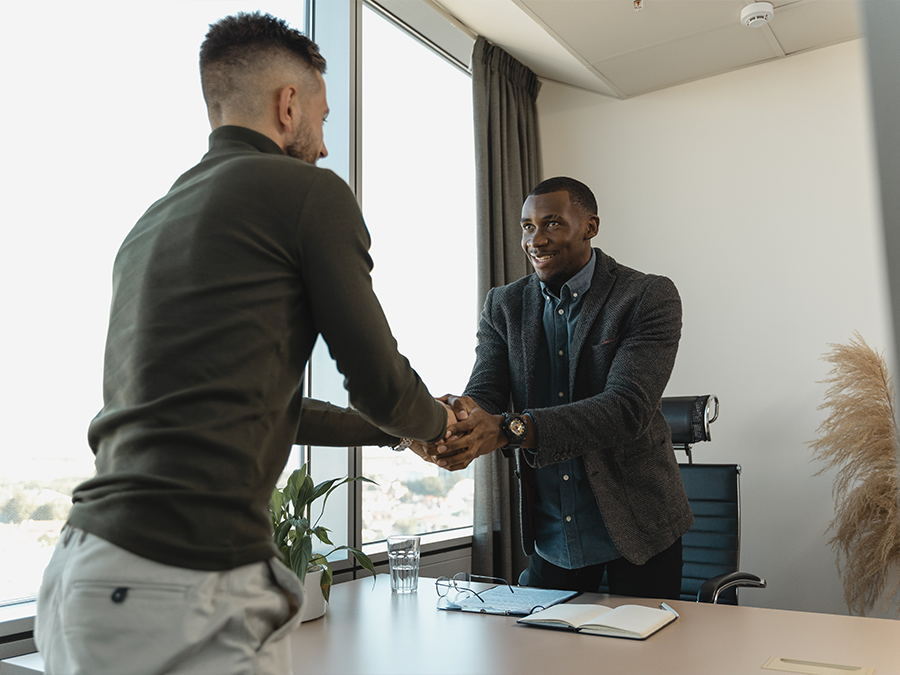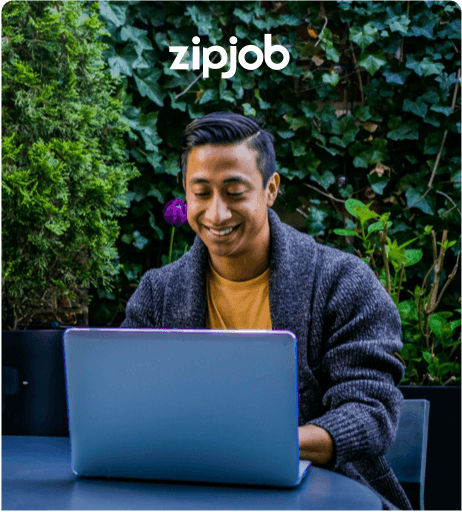Interview Outfit Tips: Dressing for Success

Boost your chances of winning over the hiring manager.
Your resume is the first impression your career makes on a company, showcasing your skills, qualifications, and experience. Similarly, your interview outfit creates the initial impression of you as a person. Find the right balance between the appropriate style and something that reflects your personality.
In this article, we’ll guide you on how to pick the ideal outfit for an interview. Read our tips and you are certain to dress to impress!
Tip 1: Do your research
First things first, you need to do some research. When you pick that just-right outfit, the interviewer immediately knows whether you understand the nature of the company’s business.
Here are some effective ways to gauge the dress code:
Visit the company's website: Take note of how the staff members are dressed in the team photos. While these pictures may showcase slightly more formal attire, they still provide valuable cues about the overall dress code.
Check social media platforms: Explore the company's social media profiles, especially LinkedIn, for images of in-house events. These candid photos often offer a more realistic representation of the company's dress code.
Consider the type of business. If you are going for a job in a law firm, chances are you need to wear formal attire. However, if you are aiming for a role in a creative agency, you can probably opt for something more casual instead.
When picking an outfit for an interview, you want to align as closely as possible with the vibe of the business. For that reason, it’s always important to do some much-needed digging first.
Tip 2: Pick a style of business clothing
Now that you have a bit of an understanding of how the employees dress, it's important to know how to define what you’re looking at. This approach will help you choose an outfit for your interview. Luckily, there are only two main styles of interview-appropriate clothing:
Option 1: Business casual. The world has become a bit more relaxed, so business casual interview outfits are trending. So much so that marketers are trying to redefine the term business casual to something like “business comfort” or “workleisure.” Business casual interview outfits are usually simple and include things like trousers, skirts, khakis, blouses, polo shirts, and sports coats.
Option 2: Business formal. Business formal attire represents the highest level of professional attire and often requires a suit. It's advisable to opt for matching pants or a skirt and a jacket. Neutral colors such as black, brown, navy blue, or gray are generally recommended for business suits.
What is business casual attire?
It may seem strange to put on everyday clothes for a job interview; however, business casual clothes are often worn in outside-of-work settings. Of course, this doesn’t mean you can wear jeans and a t-shirt. In fact, you should never wear jeans and a t-shirt to a job interview – even if you’re applying for a role as a fry cook. With that said, what does business casual look like?
Tops: It’s best to stick with light colors and something with buttons, whether you wear a blouse or a shirt. Feel free to pair your top with a scarf, cardigan, or sports coat.
Bottoms: Choose a dark-colored pair of slacks or a skirt – knee length or longer – and a matching belt.
Shoes: There’s a line in a popular movie, “How often do you look at a man’s shoes?” The answer to that question for an interview is “very often.” Your shoes can make or break your outfit, so choose wisely. Wear black or brown loafers, close-toed flats, or pumps. Do not wear tennis shoes, and obviously, avoid shoes that are scuffed or dirty.
Accessories: Jewelry, including a watch, necklace, earrings, rings, and bracelets, is the best way to elevate an outfit. Remember that less is more. Avoid statement pieces – accessories that are too bold can be distracting. Keep the word “subtle” in mind as you choose your jewelry.
When to wear business casual clothes
There is an old adage that you should dress for the job you want rather than the job you’re interviewing for. That’s true. It is always better to err on the side of dressing too well for a job. However, it also helps to know which jobs wear what type of clothing.
Here’s a sampling of where you could wear business casual clothes:
Job fair
Labor or shift work
Many information technology roles
Teaching
Work from home
Reception work
Retail
What is business formal attire?
When you’re applying for a leadership position or management role, you want to put together something more formal. You may have heard that your clothes boost confidence and change the way you think in certain situations. There’s actually a term for this phenomenon. It’s called “enclothed cognition.”
The idea is often credited to something Mark Twain wrote, but the origins of “clothes make the man” go back much further. People have been judging others based on what they wear for hundreds of years.
Make sure they’re judging you positively by following these ideas for business formal wear:
Pantsuits and suits: Within the confines of keeping it simple, a nice pantsuit is a perfect choice. Select one that’s a dark color – black, navy blue, or gray – and have it professionally cleaned and pressed. Your pantsuit can also be a skirt-suit if you choose. Pencil skirts are a great option, as long as the skirt falls to your knees at the minimum.
Shirts: You want to choose collared, button shirts in a neutral color – white or blue, for example. A great way to up-style your professional shirt is to wear cufflinks.
Shoes: Put your best foot forward, literally, by making sure your shoes have clean lines. Oxfords and loafers are perfect choices. You can also opt for a boot or low heels. Avoid stilettos and open-toed shoes.
Accessories: Just like with business casual attire, select accessories that aren’t chunky. Choose classics like stud earrings, conservative necklaces, and a simple watch. The biggest difference between business casual and business formal accessories is the tie. While you may have a bold personality and would normally select a tie to match, don’t do that for your job interview. Leave the conversation ties for after you get the job.
When to wear business formal clothes
Business formal clothes allow you to show that you pay attention to details without ever saying a word. What you wear should never be wrinkled, and everything should match from head to toe. Wearing business formal clothes for a job interview helps to set expectations. Show the hiring manager that you expect to be an asset to their team.
Here’s a sampling of where you should wear business formal clothes:
Attorney roles
Finance professionals
Three-letter roles (CEO, CFO, CIO, and COO, for example)
Roles with the word “Director” in the title
Real estate
Awards ceremonies
Client meetings
Tip 3: Dress for the industry you’re in
Spoiler: Dress codes can vary significantly across different industries and companies, making it essential to understand the expectations and cultural norms of your prospective workplace.
By decoding dress codes, you can ensure that your interview outfit aligns with industry standards and showcases your professionalism. Here's a closer look at dress codes in various industries and tips for researching the dress code of the company you’re interviewing with.
In corporate environments, a formal dress code is often the norm. This includes tailored suits, conservative colors, and polished accessories. It's important to convey a sense of professionalism and sophistication in these settings.
Creative industries, on the other hand, often embrace a more relaxed dress code that allows for individuality and self-expression. While it may be less formal, it's still important to strike a balance between showcasing your personal style and maintaining a professional appearance.
Tech companies often have a casual or business casual dress code, reflecting their more laid-back and innovative culture. However, it's important not to confuse casual with sloppy. Opt for clean and well-fitted clothing that still conveys professionalism.
Healthcare environments typically have specific dress code requirements to ensure hygiene and maintain a polished appearance. This often includes wearing scrubs or professional attire that adheres to industry guidelines.
As before, visit their website or social media pages to gain insights into their company culture and how employees typically dress. You can also network with current or former employees to gain valuable insights into the company's dress expectations.
Tip 4: Avoid common mistakes
Interviewing for a role in a strict office setting means that business casual clothes just won’t cut it. On the other hand, overdressing can give off the impression that you’re overqualified. By doing a modicum of research and following this guide, you’ll be well on your way to making a great first impression during your job interview.
Now that you have a better idea of what to wear let’s talk about what not to wear. Here are some of the common mistakes that you want to avoid:
Anything that’s wrinkled
Open-toed sandals
Tank tops or sleeveless shirts
Revealing clothing
Shorts and jeans
Visible underwear – this includes bra straps and the top of your briefs or boxers
Skirts that are shorter than knee-length
Perfume or cologne – don’t wear any at all
As a general rule, if you’re not sure whether you should wear a certain thing, don’t do it. The fact that you are questioning the decision means it is likely the wrong one. Picking an appropriate outfit for an interview can be tough. However, it’s best to go down the conservative route.
Tip 5: Keep hair and makeup neutral
Outside of work, you may enjoy wearing bold lipstick and glitter eyeshadow or have disheveled hair. If Harry Potter can pull off the mussed-up hair look, you can, too, right? Well, no. When you walk into that interview office, you’re supposed to be the best you that you can be. This includes shaving, having a clean-cut hairdo, and muted makeup.
Hair advice
If you have long hair, style it in a way that keeps it out of your face. Make sure that it’s clean and brushed out. Nothing says lack of attention to detail better than walking into an interview with oily hair. With regard to facial hair, clean-shaven is best; however, facial hair is okay for a job interview as long as it is neatly groomed.
Makeup advice
It’s also okay to wear makeup to an interview. Stick to neutral colors and subtle lines. Use the least amount of product possible to make the skin on your face appear smooth. Ultimately, you want to avoid bold colors that could distract the hiring manager from what you’re saying in response to the interview questions.
Bonus: Quick tips to keep in mind
Never underestimate your first impression. It serves as a powerful tool to convey your professionalism, confidence, and attention to detail. By mastering the art of selecting the right outfit, you can significantly enhance your chances of success and career progression. Here are some final tips that you can keep in mind:
Comfort matters. When choosing an outfit for an interview, make sure that you feel comfortable. If you look uncomfortable in your own skin, that is a bad move.
Get the fit right. Whatever you choose to wear, make sure that it fits you well. Nothing says unprofessional like wearing shoes that you’re sliding out of.
Keep colors neutral. If in doubt, make sure that the colors you choose are neutral. That way, you won’t stand out for all the wrong reasons.
Final thoughts
As we come to the end of our discussion on interview outfits and the significance they hold in making a great first impression, it's evident that your choice of attire goes beyond mere clothing. Remember, your interview outfit is a reflection of your personal brand and the value you can bring to an organization. By presenting yourself in a polished and appropriate manner, you demonstrate your professionalism and dedication to success. Take the time to carefully select your attire, paying attention to details such as color, fit, and accessories.
Not getting calls to interviews? Improve your chances of needing the perfect job interview outfit by perfecting your resume. ZipJob has a team of expert resume writers waiting to help and also offers free resume reviews.
This post was originally written by Marsha Hebert and updated by Charlotte Grainger.

